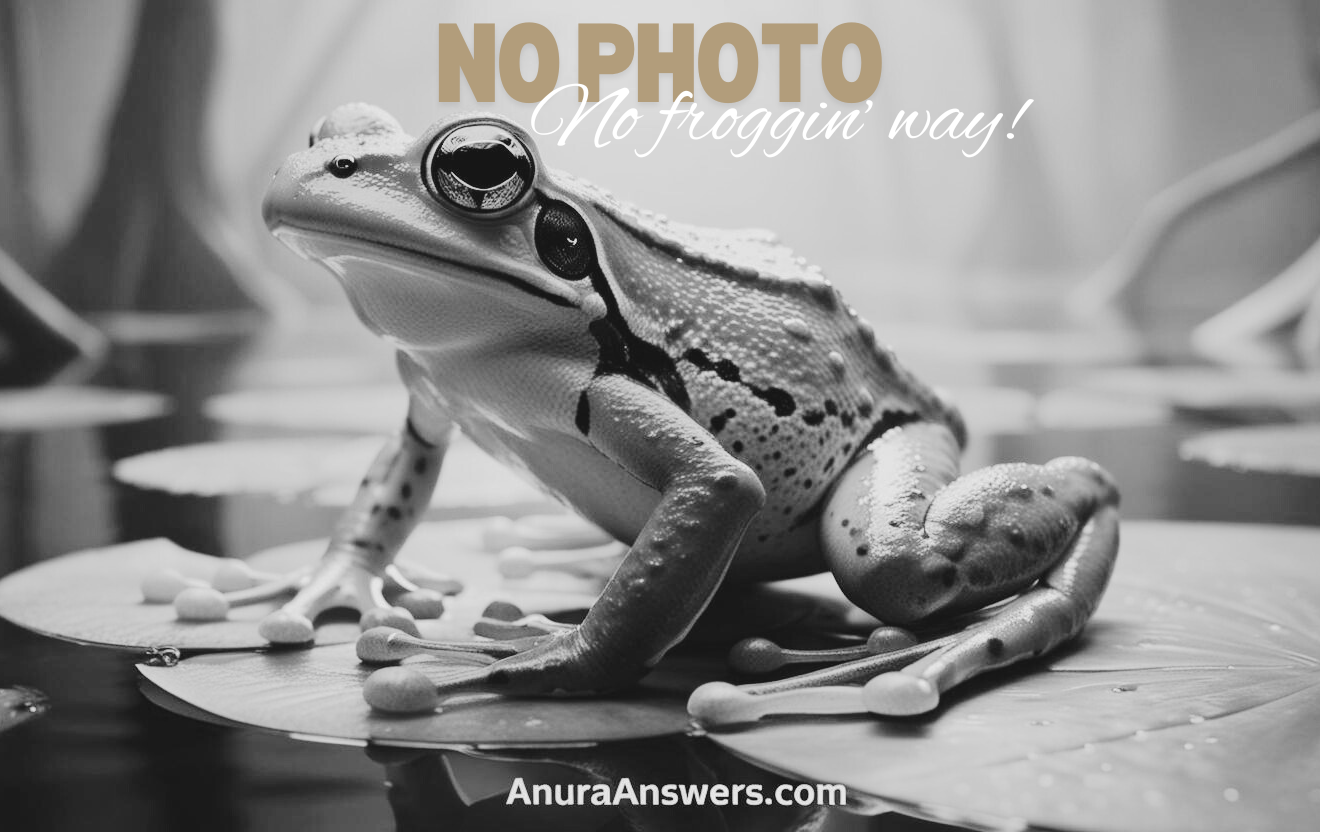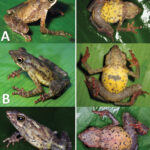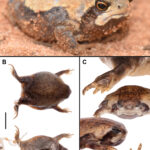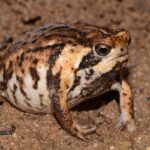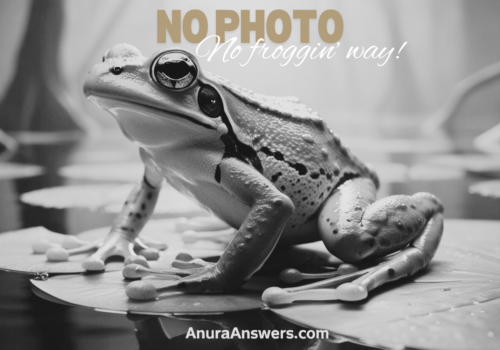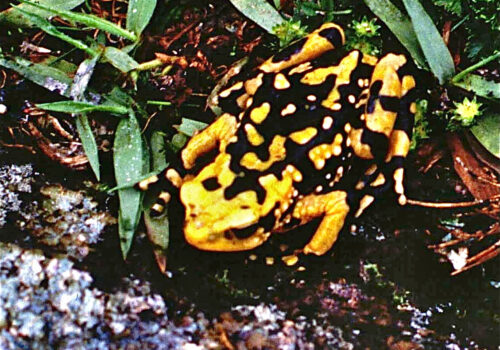- Atelopus Pachydermus: The Enchanting Tale of Ecuador’s Elusive Harlequin Toad
- Taxonomy and Classification
- Natural Habitat
- Physical Characteristics
- Behavior and Life Cycle
- Ecological Role
- Threats and Conservation Status
- Cultural and Scientific Significance
- Conclusion: Protecting Ecuador’s Icon of Fragile Biodiversity
Atelopus Pachydermus: The Enchanting Tale of Ecuador’s Elusive Harlequin Toad#
Hidden deep within the lush cloud forests of Ecuador, blending seamlessly into debris-covered streams and moss-laden rocks, lives Atelopus pachydermus—a remarkable creature among amphibians, one whose very existence symbolizes resilience in the face of climate challenges and habitat disruptions. Known commonly as the harlequin toad due to its mesmerizing coloration patterns, this amphibian’s skin, curiously rugged to touch, conceals potent secrets of adaptation and survival.
Long praised by biologists and conservationists alike, the critically endangered Atelopus pachydermus exemplifies the fragile beauty of biodiversity. Although its appearance alone captures observers’ hearts, under its bumpy, wart-like exterior lies a poignant symbol of ecological fragility, calling for urgent conservation actions to secure its future.
Taxonomy and Classification#
Atelopus pachydermus belongs to the fascinating family Bufonidae, comprising true toads, and resides within the genus Atelopus, commonly known as harlequin toads. This genus is famous for its vibrant coloration, unique skin textures, and intriguing life histories, serving both as warning signals against predators and as adaptive camouflage strategies within complex forest environments.
The taxonomy of Atelopus pachydermus has been clearly defined since its initial scientific description. Its scientific epithet “pachydermus,” meaning “thick-skinned,” refers to the curious and tough texture that distinguishes it from closely related species such as Atelopus ignescens and Atelopus bomolochos. Such morphological characteristics offer not only visual fascination but biological functions that nurture survival in challenging habitats.
Natural Habitat#
The harlequin toad Atelopus pachydermus predominantly inhabits Ecuador’s cloud forests and subtropical rainforests, specifically found in steep, humid montane regions on the western slopes of the Andes. Historical range data indicate populations scattered across provinces such as Bolívar, Chimborazo, and Cañar—elevations between 2,400 and 3,000 meters above sea level providing the ideal climate conditions and vegetation structure vital to the species’ survival.
Walking within these habitats reveals a dreamlike environment: persistent mist envelops twisted branches covered in flourishing bromeliads and orchids, casting a surreal shade across forest streams. Here, amidst scattered boulders, fallen leaves, and flowing rivulets, the harlequin toad skillfully camouflages itself, its vibrant skin patterns merging with the dappled colors of the wet forest floor. This specialized niche provides moisture crucial for skin respiration, abundant invertebrates for prey, and swift-flowing water essential for breeding and tadpole development.
Physical Characteristics#
The first encounter with Atelopus pachydermus never fails to astonish even seasoned herpetologists. Measuring anywhere between 4 to 6 centimeters in length, this small amphibian impresses observers beyond its modest size due to its remarkable coloration patterns—brilliant shades of green and yellow interwoven into mesmerizing stripes and distinctive irregular blotches.
Yet perhaps its most striking feature resides in the texture of its skin—exceptionally rough and wart-like, a trait from which derives its species name. Far from aesthetical anomalies, these features possess pivotal adaptive benefits; the thick, bumpy skin reduces evaporative water loss and enhances protection against mechanical injuries and predators. Scientists hypothesize that this unusual dermal ruggedness also amplifies glandular secretions which, when combined with bright coloration, advertise toxicity—a key evolutionary deterrent to predators.
Behavior and Life Cycle#
Feeding Habits and Foraging Strategies#
Like other toads within the genus, Atelopus pachydermus is primarily insectivorous. A quiet wanderer among the leaf litter, its keen eyesight spots ants, beetles, small spiders, and other invertebrate prey passing by. Its agile tongue swiftly shoots out to capture its target with remarkable accuracy, a spectacle one rarely witnesses in person.
Breeding and Reproductive Behavior#
The arrival of heavy seasonal rains signals a breeding event—a vital and delicate orchestration where the males gather at noisy streams, producing subtle, high-pitched calls surprisingly soft and gentle compared to frog calls elsewhere in the amphibian landscape. Males establish territories along stream edges, and as females approach, mating occurs in the streams, followed by vocal choruses echoing softly amid dense vegetation.
Female harlequin toads deposit strings of gelatinous eggs underwater, often attaching clusters to submerged rocks or vegetation. Soon after fertilization, tiny black-and-brown tadpoles emerge, initiating a perilous journey to adulthood. Environmental stability, particularly clean running waters, remains essential for tadpole survival, making this amphibian especially vulnerable to habitat disruptions and contaminants.
Ecological Role#
Atelopus pachydermus contributes significantly to the ecological tapestry of high-altitude rainforests, playing a dual role as both predator and prey. By consuming enormous numbers of insects, these toads regulate invertebrate populations, indirectly influencing vegetation structure and forest insects’ dynamics. Equally important, the species itself provides crucial food resources for various animals, including snakes, larger amphibians, and numerous bird species.
Perhaps their most critical ecological service, however, is their role as bioindicators—highlighting ecosystem health. Because amphibians absorb water and gases directly through their permeable skins, their populations swiftly indicate deviations in water quality, pollutant levels, and climate change impacts, rendering them frontline alarms for environmental disruptions in forest ecosystems.
Threats and Conservation Status#
Sadly, the vibrant presence of Atelopus pachydermus has significantly diminished in recent decades. The International Union for Conservation of Nature (IUCN) lists the species as “Critically Endangered,” primarily due to drastic population declines believed attributed to habitat destruction, climate change, and notably, the spread of amphibian chytrid fungus (Batrachochytrium dendrobatidis), an infectious disease devastating amphibian populations worldwide.
Deforestation associated with agriculture, logging, and expanding urban boundaries isolates and fragments forest habitats critical for breeding and survival. Global climate disruptions have altered precipitation patterns, further threatening water resource availability during the reproductive seasons. Conservation efforts, such as habitat protection, captive breeding programs, scientific monitoring, and disease management strategies, are urgent priorities actively coordinated by dedicated organizations to safeguard the endangered species.
Cultural and Scientific Significance#
In local indigenous beliefs, frogs and toads represent symbols of fertility, transformation, and renewal. Though direct cultural references to Atelopus pachydermus specifically remain scarce, by extension, its image embodies the greater importance these biotic symbols have on indigenous cultural narratives, emphasizing sustainability and environmental interconnectedness adored in broader Andean folklore.
Scientifically, the unique skin toxins harbored by this species promise novel biochemical properties, potentially valuable in medical research and pharmacology. Furthermore, diverse parental care adaptations, breeding strategies, and skin secretions in Atelopus species continue to help scientists unlock vital understandings surrounding amphibian biodiversity, evolutionary biology, and ecological resilience.
Conclusion: Protecting Ecuador’s Icon of Fragile Biodiversity#
Atelopus pachydermus embodies both the vibrant diversity and delicate vulnerability of Ecuador’s cloud forests. With every vanished population, humanity loses not merely a beautiful and unique amphibian but vital ecological services, cultural richness, and potentially invaluable scientific knowledge necessary for life’s greater tapestry.
Our responsibility as stewards of this planet compels action—supporting habitat conservation, advocating for sustainable development practices, and championing scientific research to protect and restore this extraordinary amphibian. Let us amplify conservation voices, nurture awareness, and sustain collaborative global efforts to ensure that future generations may, too, marvel at the beauty, resilience, and ecological significance of Ecuador’s enchanting harlequin toad, Atelopus pachydermus.
